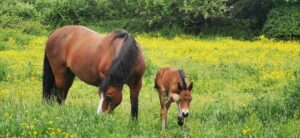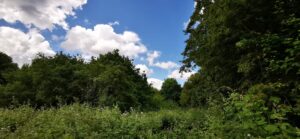Why are Trees & the Environment Important?
Fighting Carbon Emissions
Different types of environment but both able to help with air quality. For example, R16 contains two completely different environments:
- Pasture & scrub – the horses field, and
- Woodland – the bit with trees.
Oddly, we tend to think of Trees being the ultimate carbon fixing plants but pasture, particularly if mature (as the horses field is) is also great. This extract below is from equiculture.net:

“Good biodiverse (tall) pasture has a very high carbon storage capacity. Much more so than lawns and golf courses for example. Grass plants have roots that are as long and abundant underground as above ground – in other words, what you see above ground is mirrored underground in the root system. As the plants grow taller their roots thicken and reach further down.
When the plants are grazed their roots die back temporarily, which builds up organic matter (and carbon) in the soil. And then new roots regrow as the plant above ground regrows. This is one way that carbon is taken out of the atmosphere and stored in the soil.”
— equiculture.net
Obviously, trees are also important. The UK Government is committed to planting 30,000 hectares a year; this is a 4% increase & will hopefully reduce CO2 by 24%. But, of course, these are new trees…

“… all forestry institutions agree that a tree absorbs the maximum amount of carbon when it’s in full growth, and that a young tree collects only very little, as its size limits the photosynthesis process.”
— Nature (Journal)
So cutting down the trees in R16 will simply result in less carbon capture.
Blue & Green Corridors
We are all getting used to seeing more wildlife in the built environment; sadly, all too often, squished at the side of the road. Plots like these afford protected corridors where wildlife can move more safely.
Mental Health & Wellbeing
There is a clear correlation between mental health & wellbeing and the presence of green spaces. Read more here.
Local Plan Policy NE03
The Local Plan Policy on Trees, Woodlands & Hedgerows is framed in the context of the Town & Country Planning Act 1990, the Tree Regulations 2012, and Hedgerow Regulations 1997. They acknowledge in the Local Plan that:
Trees, woodlands, hedges and hedgerows provide important habitats for a range of species, provide shelter, help reduce noise and atmospheric pollution and also store carbon dioxide, helping to mitigate against climate change. They add to the character and quality of the local environment, can have historic value (e.g. ancient woodlands) and can offer recreation opportunities supporting health and well-being.
Brentwood Local Plan 8.44
The Policy
- Development proposals that would result in the deterioration or loss of irreplaceable ancient woodland and ancient and veteran trees will not be permitted other than in wholly exceptional circumstances and only if the proposals include a suitable compensation strategy. Applicants will need to demonstrate the efficacy of the strategy by reference to the value of the habitats that will be lost or harmed and provide an appropriate implementation and maintenance programme to underpin the strategy the performance of which will be subject of a condition and/or planning obligation, as appropriate.
- In all other cases, proposals should, so far as possible and practicable, seek to retain existing trees, woodlands and hedgerows where they make a positive contribution to the local landscape and/or biodiversity or which have significant amenity value. Wherever possible and appropriate, landscaping schemes should take account of and incorporate these existing features in the scheme and where any loss is unavoidable, incorporate measures to compensate for their loss.
Sign Our Online Petition
To sign the petition just click here and answer a few short questions.
